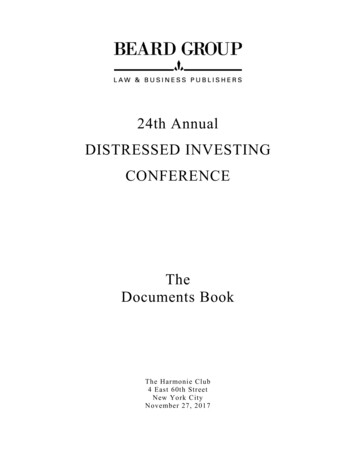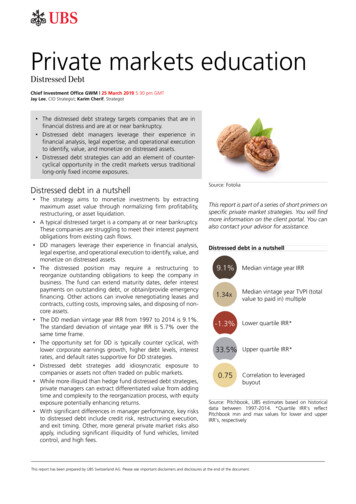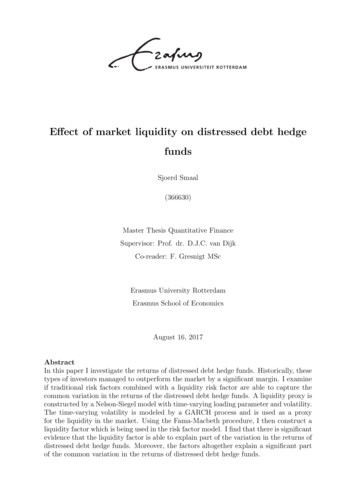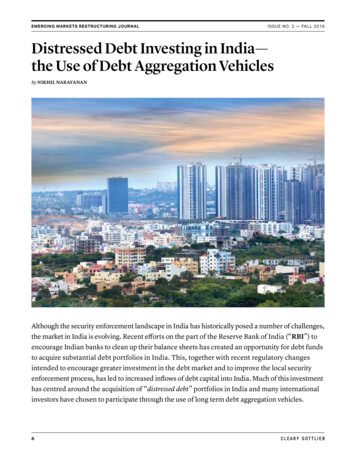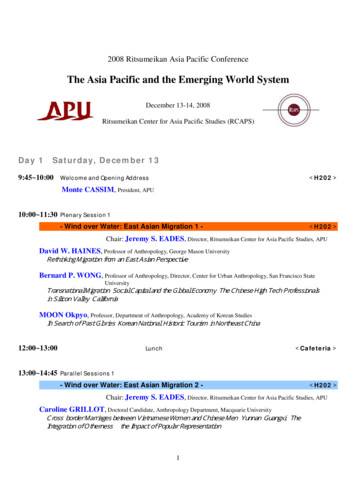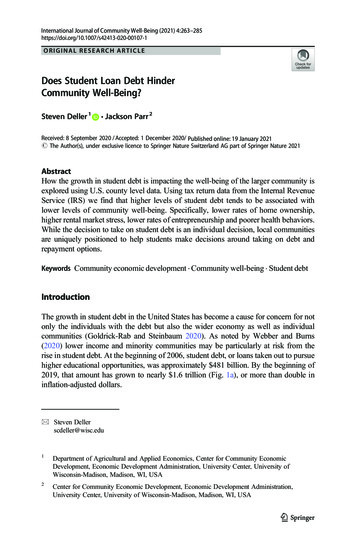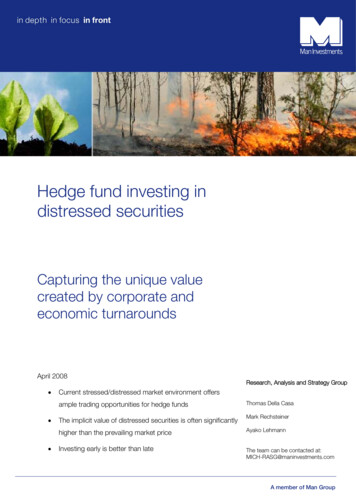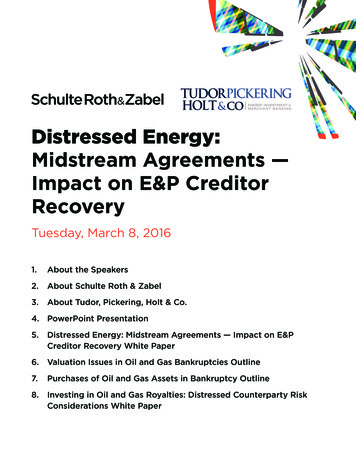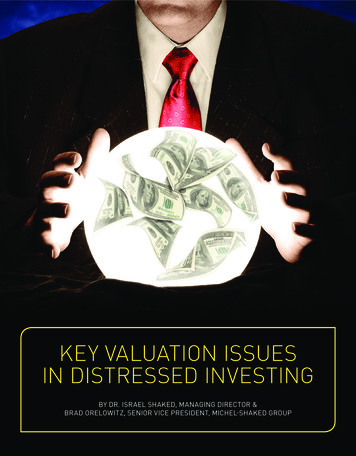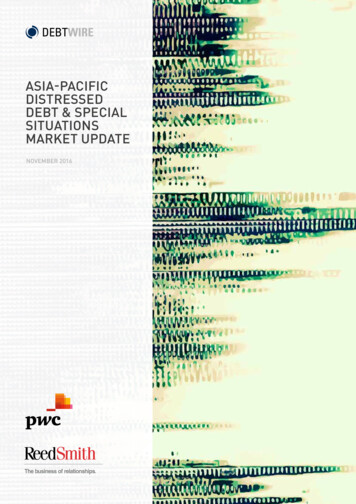
Transcription
ASIA-PACIFICDISTRESSEDDEBT & SPECIALSITUATIONSMARKET UPDATENOVEMBER 2016
CONTENTS2Foreword3Research methodology4Survey findings6Expert Q&A: PwC32Expert Q&A: Reed Smith34PwC contacts37Reed Smith contacts39
The first trading day in 2016 opened to a meltdown on China’s major stock exchanges, triggeringa circuit-breaker mechanism which suspended trading nationwide for the first time. This sparked a globalselloff that concluded with the obation of approximately US 8 trillion across stock markets worldwide.In June, Britain voted to leave the European Union, driving the pound to a 31-year low against the dollar.As the year marches through its final quarter, the combination of panic and excitement precipitated bythese events, spurred on no less by a good deal of fear-mongering, has begun to temper into a moodof watchful waiting, especially when it comes to the valuation process in deal-making. As the worldreckons with the result of the US presidential election, and while Brexit negotiations remain hangingin the air, there have been speculations of realignments in political and trade relations involving Europeand the US, prompting investors to sharpen their focus on markets in the Asia-Pacific region.In the Asia-Pacific, economies continue tosustain the ripple effects of China’s slowdownin growth, which looks set to continue as thecountry undergoes an economic rebalancing,transitioning from an export-driven economy to aconsumer-led one. Along with the unveiling of its13th Five-Year Plan at the 2016 plenary session ofthe National People’s Congress in March, Chinaannounced a target growth range of 6.5%-7%for the year. A legacy from its heyday of doubledigit ambitions, the country is seeing its nonperforming loans (NPLs) surge to increasinglyunmanageable levels. Official data stated thatthe NPL ratio of China’s commercial banks hadrisen to 1.67% at the end of 2015, and the Chinesegovernment is reported to be considering debtfor-equity swaps for banks.Luc MongeonManaging Editor, Debtwire Asia-PacificIn Q3 2016, Debtwire polled 60 private equityinvestors, prop desk traders, hedge fundmanagers, credit risk or workout managers, andemerging market investors in the Asia-Pacificregion, to gain perspectives from professionalson the ground. A number of respondents, whilerecognising the advantages of leveraging onnascent distressed opportunities in the region,are also placing emphasis on staying levelheaded and in line with their core investmentstrategies, training their focus on sectorsin which they possess prior experience andknowledge in terms of investment, operationsor turnaround processes. Nonetheless, volatilityand uncertainty remain the watchwords of theyear to come, both in economic and geopoliticalterms, and it is up to the shrewd investor to knowwhen to strike while the iron is hot.FOREWORDResource-reliant industries have been some of thehardest hit in the current climate of diminisheddemand, with oil prices freefalling from 2014in a low commodities price environment as thesector experienced oversupply. In the meantime,the shipping and steel industries are seeing theslump in demand amplify chronic overcapacity,with overleveraged companies turning to assetdivestitures and merge-to-survive strategiesin anticipation of imminent waves of industryconsolidation. With some commodity markets,such as coal and iron ore having reboundedas others have remained depressed, theopportunities for distressed debt investors areexpanding in a growing number of universes, asoverleveraged companies scramble to stay afloatupon the contraction of demand from China.For emerging Southeast Asia, deceleratingregional growth, dampened global demandand the potential for a tightening of monetarypolicy in the United States have all contributedto a mounting corporate debt burden, whichmay translate into more distressed and specialsituation opportunities over the next 12 months.Meanwhile, Singapore, an advanced and openeconomy accustomed to punching above its weight,has set its sights on higher targets. By dint of itstransparent governance, business efficient, aswell as strong legal and regulatory frameworks,the nation-state is positioning itself as a hub tofacilitate restructuring work in the region.3
In the third quarter of 2016, Debtwire canvassed the opinions of 60private equity investors, prop desk traders, hedge fund managers,credit risk or workout managers, and emerging market investorsin the Asia-Pacific region.RESEARCH METHODOLOGYRespondents were questioned about their expectations for theAsia-Pacific distressed debt and special situations market overthe next 12 months. The respondents were guaranteed anonymity.Responses were collated by Debtwire and are presented in aggregate.Percentages may not add up to 100% due to rounding.4DISTRESSED DEBTSPECIAL SITUATIONSDistressed debt in general refersto high-risk debt securities whichare in default or bear a significantchance of defaulting in the nearfuture, and typically sell at adepressed percentage of par valuewith a potential for high return.Special situations arecircumstances in which thetrade of a security is motivatedby conditions pertinent to thesituation, such as a change invaluation, making the situationevent-driven.Please confirm that your firm isprimarily a .Please describe your coreinvestment strategy.2% 2%5%10%17%27%17%50%25%27%Key:20%Key:Private equity investorMulti-strategyProprietary trading desk at bankor investment bankDistressed debtHedge fundPrivate equityBank/investment bank credit riskmanagement/credit workout departmentSecondary tradingEmerging market investorHigh yieldEvent driven
ASIA-PACIFIC DISTRESSED DEBT & SPECIAL SITUATIONS MARKET UPDATEPlease indicate all geographies in which you have madedistressed debt/special situations investment in the last two a28%Vietnam27%Malaysia25%15%No, we are decreasingour allocation17%PhilippinesNew Zealand30%No, ourallocationwill remainthe same37%ThailandSingapore55%Yes45%South KoreaTaiwanFor the next 12 months, is your firmsetting aside more capital for distressed debt?15%13%8%Percentage of respondents5
Excluding advisory work, what percentage of distressed debt or special situationsin Asia-Pacific that you explored in the last 12 months have represented an actionableand attractive investment opportunity?According to 65% of respondents, a sizeable26-50% of distressed debt or special situationsin Asia-Pacific that they explored in the last 12months have represented an actionable andattractive investment opportunity. Almost onefifth (18%) venture further to say 51-75%, while15% saw less than 25% of the situations eventuallytranspose into opportunities.“Most respondents felt that at least one infour distressed debt or special situationopportunities explored in the region wereattractive. This reflects the extent and qualityof opportunities in the region and suggests thatsupply should be able to continue to meet theappetite of the investment community.”6Percentage of respondentsSURVEY FINDINGS—Peter Greaves, Partner, PwC Singapore65%18%15%2%Less than 25%26-50%51-75%76-100%
ASIA-PACIFIC DISTRESSED DEBT & SPECIAL SITUATIONS MARKET UPDATEMarket volatility over the next 12 months will be:While there are regional variations and manycountries are trying to maintain momentum andmake modest improvements in growth amidstdivergent monetary policies, a market recoveryis unlikely to transpire over the next 12 monthsas currency values fluctuate and the regulatorylandscape changes its countenance. Citinglackluster portfolio performances, the ChiefExecutive Officer of a prop desk at a bank inTaiwan observes, “Investors have not been ableto generate value on their investments by investingin the stock market and thus their participationthere will reduce. This will impact the marketsignificantly and therefore added volatility willprevail over the next year or so.”A number of respondents have also identifiedthe low commodities price environment as acontributory factor, with the Chief InvestmentOfficer at a hedge fund in Hong Kong pointingout, “Falling commodity prices have affectedbusinesses and forced them to undertakerestructuring activities, which will keep theeconomies low till the businesses are thoroughlyready to introduce their growth strategies whichwill take at least another year. Till then, marketvolatility will continue to increase.”A minority group of respondents (10%) take amore optimistic view, anticipating that volatilitywill remain about the same as that over the last12 months. However, only 2% of respondents haveindicated expectations for market volatility todecrease over the next 12 months.“Navigating pockets of volatility can bechallenging for the market, but at the sametime volatility provides definite opportunitiesfor restructuring and investment for thoseinvestors with risk appetite. There seems to bepositive sentiment throughout the market fornew opportunities to present themselves overthe next 12 months.”—Diane Roberts, Restructuring Partner,Reed Smith“After an extremely volatile 2015 and 2016,almost all (98%) respondents expect this topersist or increase in the next 12-18 months.This confirms our view that there will be nolet-up in new opportunities becoming available.Earlier in the year, there was more optimismof steadying markets. However, recent eventsand the prolonged depression in certain keysectors such as offshore and marine, alongwith some high profile defaults, have increasedthe markets’ expectations of volatility in recentmonths.”—Peter Greaves, Partner, PwC SingaporePercentage of respondentsThe vast majority (88%) of survey respondentsexpect market volatility over the next 12months to rise. Against the backdrop of China’scontinuing slowdown in growth and the ongoingEurozone crisis, several respondents attributethis to geopolitical uncertainty emanating fromthe United Kingdom’s vote to leave the EuropeanUnion, as well as the result of the presidentialelection in the United States. In light of theunpredictable macroeconomic climate, the ChiefFinancial Officer of a prop desk at a bank in Japanelaborates, “It has become very challenging forbusinesses to run their operations as usual due tothe recent uncertainties affecting the market andthus economic performance appears stagnant.Pressures to reduce costs are increasing andbusinesses are facing business continuitychallenges, which is affecting the investors.This negative business environment and lack ofgovernment support to drive performance willincrease the level of volatilityin the market.”88%Greater than that overthe last 12 months10%2%About the sameLess than that overthe last 12 months7
By how much will the Chinese economy grow over the next 12 months?0%100% of respondents expect the Chinese economyto grow by no more than 7.5% over the next 12months, with 90% anticipating a growth rate of 3.5%7.5% and 8% predicting 7.5% growth. Meanwhile,2% of respondents forecast a growth rate of lowerthan 3.5%. Rising corporate debt (a problem madeurgent in a time of weakening international demandand lower exports in a low commodities priceenvironment) together with fiscal deficits, regionalcompetition and the devaluation of the yuan aredampening China’s growth prospects. Elaboratingon the effect of corporate debt exacerbated by a risein underperforming assets, the Managing Directorof a hedge fund based in India explains, “The marketis going to face the consequences of their high debtlevels and the decreasing size of operating unitscaused by high pressures on operational expensesand these negative factors are affecting theeconomic growth rate.”Touching on industry consolidation and the reductionof excess supply capacity, rising opportunities andintensifying competition from emerging regionaleconomies, as well as reduced foreign directinvestment, the Partner & Chief Operation Officer ofa prop desk at a bank in Hong Kong says, “Expectedunemployment as a result of the decreasedproduction houses and rise of more stable emergingcountries and investment opportunities are impactingthe Chinese economy to a certain extent and hence itsgrowth will be minimum in the next 12 months.”Similarly the Director of Investment at a hedge fundin Malaysia opines, “It has become challenging forbusinesses in China to continue their large capacityoperations as the regulations to its exports haveincreased significantly, causing an increase in coststo the buyers and therefore the Chinese will lose outon a lot of international business opportunities whichwill impact their economy.”“Following the reduced growth in China, we areseeing a direct impact on the natural resourcesand commodities sectors, and accordingly thecompanies connected to those sectors.”—Matthew Gorman, Partner, Singapore,Reed Smith100% expect the Chineseeconomy to grow byno more than 7.5% in thenext 12 months.88%2%90%Key:Lower than 3.5%3.5%-7.5%7.5%Higher than 7.5%
ASIA-PACIFIC DISTRESSED DEBT & SPECIAL SITUATIONS MARKET UPDATEWill liquidity conditions over the next 12 months be about the same, worse or better thanthose in the last 12 months?In their outlook for liquidity conditions over the next12 months, more than half the survey participants(62%) take the position that liquidity conditions willbe worse than those seen in the last 12 months, with37% expecting conditions to maintain the status quo,and a mere 2% anticipating better conditions thanthose seen in the last 12 months.The Managing Director of a private equity firmin Hong Kong explains, “Liquidity conditionswill continue to worsen in the next 12 monthsas economies are being affected by risinguncertainties and risk. The appetite for newinvestments has reduced considerably as themarket conditions are unfavourable to derivesufficient returns and therefore the liquidityconditions are being impacted significantly.”Percentage of respondentsAccording to the Head of Investment of a privateequity firm in Japan, “The volatility in the oil pricesis likely to exert increased pressure on fundingenvironments – it has reduced deposit inflows andhave affected the lending interest rates and hencethe liquidity conditions are likely to worsen.”62%Liquidity conditions may vary across geographies,and while some regional governments are showingsigns of being more willing to ease regulationsand reduce interest rates to strengthen weakenedeconomies, others are maintaining tight regulatorystandards and policies. As the Managing Directorof a private equity firm in South Korea pointsout, “The equity markets are being impacted bythe fluctuating currency values and depreciatingbusiness performance depicted by firms in theemerging markets caused as a result of the recentchanges in the regulatory environment and thereforethe liquidity conditions will worsen till there arepositive signs of economic recovery and faster paceof growth.”To generate funds and strengthen cash flows,large corporates are divesting non-core andunder-yielding assets, while others in the marketare creating more liquid finances by way ofrestructurings, reorganisations and scaling back.“Whilst the feedback suggests that most expecttighter liquidity there is no outright consensus.However the nature of the liquidity (in termsof providers) is certainly shifting. This dynamichas already been seen extensively in Europe.Corporates might therefore expect to see achange in their type of capital providers asrefinancings or restructurings occur in thecoming year, and that pricing may also increaseas the funders providing the required capitalwill require a higher return than the incumbentfunder. On the flip side, it also suggests thatthere will be strong opportunities for fixedincome investment in those situations wherethe incumbent lenders and corporates canagree on realistic values relative to the size andurgency of the funding requirement.”—Peter Greaves, Partner, PwC Singapore37%“Anticipated liquidity contractions fromregulated banks may be partially eased oroff-set by new entrants to the lending andrestructuring market, including credit fundsand distressed investors.”2%Better thanthose seenin the last12 monthsAbout thesameWorse thanthose seenin the last12 months—Charlotte Moller, Restructuring Partner,Reed Smith9
What do you expect for the amount of distressed debt and special situation opportunitiesin Asia-Pacific (inclusive of Japan and Australia) in the next 12 months?With China’s deceleration and the negative rippleeffect on its neighbours, 58% of respondents expectthe amount of Asia-Pacific distressed debt to riseover the next 12 months, while a far greater 80% ofrespondents expect special situation opportunities,such as buyouts and recapitalisations, to increaseover the same period. In light of continued volatilityacross global stock markets, 32% of respondentsare expecting distressed debt levels to stall and 20%think the amount of special situation opportunitieswill remain the same. 10% of respondents foresee adecrease in distressed debt opportunities, while norespondents expect special situations opportunitiesto falter.Expressing the view that special situationtransactions offer more scope for refinancing andbusiness continuity plans, the Head of InvestmentBanking at a bank in Japan states, “The likelihoodof an increase in special situation opportunities ishigh as it allows business leaders to stay involvedin the business despite the transfer of assets to theinvestor and this strategy is also doing well as thereare fewer risks involved in this.”Accounting for the greater expectations towards arise in special situation opportunities, the ExecutiveVice President of Finance at a bank in Japan explains,“Restructuring managerial competencies is greatlyhelping businesses across the globe and fundingsourced through social growth negotiations is evenbetter for the economy and thus I believe in order togrow along with the economy most businesses in thissituation will consider special situation deals overdistressed deals.”Suggesting that special situations can occur asa result of efforts to keep debt from going intodistress, a Partner at a private equity firm in HongKong says, “The gradual effect on the credit marketis increasing the demand for special situationactivities. Entering an equally negotiated deal ishelping businesses transform their performance,leaving the distressed phase and entering newgrowth heights.”“2015 and 2016 were clearly very active fordistressed debt and special situations andthe view appears to be that next year willcontinue along that trend. When you look atthe expectations of what themes will be, andcombine these with some of the expectedhurdles to restructuring that are cited later inthis survey, these may reflect that portfolioshave not been through the extent of pain thatthe market conditions would suggest is to beexpected. Therefore, until this is fully realisedand dealt with, we should not expect to seethe level of distressed debt and specialsituations declining.”—Peter Greaves, Partner, PwC SingaporeKey:Percentage of respondentsDistressed debtSpecial situations80%58%32%20%10%Increase10Remain the sameDecrease0%
ASIA-PACIFIC DISTRESSED DEBT & SPECIAL SITUATIONS MARKET UPDATEIs your firm setting aside more capital for distressed debt and special situationopportunities in Asia-Pacific (inclusive of Japan and Australia) in the next 12 months?More than half (58%) of those surveyed state thattheir firms are apportioning more capital towardsthe distressed debt universe in the Asia-Pacificregion in the next 12 months, while a greater68% plan to raise their current levels of capitalallocations towards special situations over thesame period. Distressed debt investors often lookto gain from low valuations, with some playingthe role of opportunistic bargain hunters lookingfor quality distressed assets at undervalued ordiscount prices. Elaborating on the heightenedinterest in special situations, a Partner at a privateequity firm in Hong Kong states, “We believespecial situations will help us manage time risk,price risk and deal risks more effectively, givingus higher chances of improving our return oninvestment rate.”Amid concerns over overcrowding in thedistressed investment field, an additional 30%and 32% of respondents indicate they will maintaintheir current levels of capital allocation fordistressed debt and special situation opportunitiesrespectively, while 12% are looking to decreasetheir allocation towards distressed debt, withno respondents planning to cut back on allocationsfor special situations.“Our clients have been raising capital forinvestment and tell us that they are patientlywaiting for opportunities to present themselves.They are cash rich and there will be ampleinvestor competition for the best investments.”—Diane Roberts, Restructuring Partner,Reed SmithMeanwhile, the Director at a hedge fundbased in Singapore opines, “Special situationfunds have been performing extremely well inscenarios where the portfolio managers arehighly experienced and qualified with regards totransformation or development of businesses andwe have identified such funds where we plan toincrease our capital allocation over the next yearto draw significant returns for our shareholders.”Key:Percentage of respondentsDistressed debtSpecial situations68%58%30%32%12%YesNo, our allocation willremain the same0%No, we are decreasingour allocation11
What percentage return are you targetingfor distressed debt transactions in the next12 months?What percentage return are you targetingfor special situation transactionsin the next 12 months?Half (50%) the respondents are targeting returnsof 15-20%, 45% are aiming for 10-15% returns,and 5% are targeting less than 10%. The ManagingDirector at a private equity firm in South Koreasays, “Concerns over rising operational costs andthe increasing number of underperforming assetsare affecting business performance and thereforewe are not able to fully leverage the potential ofour distressed assets in the market.”Most respondents (85%) are targeting 10-15%returns for special situation transactions in the next12 months. Higher returns of 15-20% are expectedby 10% of respondents, while more modest gains inthe 8-10% belt are expected by 5% of respondents.This is lower on average than what is targeted fordistressed debt transactions, possibly due in partto special situation opportunities being generallyamong the lower risk arbitrage.On regulatory barriers, a Partner at a privateequity firm in Australia explains, “New competitionlaws and compliance procedures are driving ourfocus away from improving core objectives andhence we are unlikely to meet our targets on time.Our distressed assets will see better growthin 2017 as we would have completed their riskassessments by then.”Taking a bearish view, the Managing Director ofa private equity firm in Hong Kong asserts, “Theprocess of transforming distressed businessesinto highly productive businesses is lengthy andhas been delayed even more due to the increasingchallenges faced by business managements inapplying effective profitable strategies and riskmanagement techniques.”“The regulatory framework within ajurisdiction can have a significant impacton the potential return of an investment.Accordingly, this is a key considerationto be factored into the equation when firmsare making investment decisions.”—Panos Katsambas, Special Situations Partner,Reed SmithLess than 10%“On a portfolio basis it is not unexpectedthat returns of 10-20% are targeted by most.However, given the jurisdictional and sectorspecific issues in many of the individual cases,we would expect case specific returns to beextremely volatile within a given portfolio.Whilst true turnaround stories can beprotracted, there are opportunities on fixedincome deals where high-teen returns areavailable due to short term 'burning platform'liquidity needs. These deals clearly comewith heightened default risk or subordinatedpositions, but they are there to be had.”—Peter Greaves, Partner, PwC Singapore100% targeting no more than20% return for distresseddebt and special situationtransactions in the next12 months.5%Less than 8%10-15%15-20%0%5%8-10%0%Over 20%50%45%10-15%85%15-20%10%Over 20%0%Percentage of respondents12
ASIA-PACIFIC DISTRESSED DEBT & SPECIAL SITUATIONS MARKET UPDATEIf you expect an increase in distressed debt, please indicate which of the following is/arelikely to be the cause(s). (Please indicate all that apply.)Out of the respondents forecasting an increasein distressed debt in the next 12 months, almostall (98%) are attributing its cause to China’seconomic slowdown, along with 93% citingslowing Asian economies due to monetarypolicy or regulation. The maintenance of pricestability, the controlled expansion of bank credit,and restrictions on inventories and stocks aresome elements of monetary policy that arecontributing to the slowdown in Asian economies.Expounding on the effect of China’s slowdown,the Principal at a private equity firm in Singaporeobserves, “China was considered to be the topmost economy in the Asia-Pacific region, and itsdepreciating conditions will certainly impact theeconomic recovery pace in the Asia-Pacific regionposing pressures on businesses to sell of theirunderperforming assets or restructure theircapital structures which will lead to the increasein special situation opportunities.”At the same time, 88% of respondents pointto continued problems in the Eurozone. As theManaging Director & Chief Executive Officerat a bank in China discusses, “The continuedproblems in the Eurozone are likely to impact thelargest sector in the Asia-Pacific region, which ismanufacturing, as regulatory changes and exportlaws are being tightened, reducing the demandfor Asia-Pacific goods and this will drive thedistressed and special situations environmentin the Asia-Pacific region.”Meanwhile, half (50%) the respondents haveidentified oil price volatility as a key factor.The Managing Director of a hedge fund in Indiaexplains, “The volatility in the oil prices areaffecting business financials in the Asia-Pacificregion and managements are unable to protecttheir businesses from this unseen uncertainty.In order to recover from their low performancesthey will either have to sell off their assets atcheap valuations or restructure their activitiesby gaining support from foreign acquirers, drivingdistressed opportunities in the market.”“A multitude of factors have contributed to anincrease in distressed debt, including but notlimited to the economic slowdown in China,the decrease in oil prices, the uncertainty ofthe future direction of interest rates and otherchanges to monetary policies, the increasedcosts of banking and trade regulation andthe uncertainty of the US elections andBrexit implications.”—Diane Roberts, Restructuring Partner, Reed Smith“The importance of Eurozone uncertainty isalready being seen, but unlike that in China,this does not appear to be purely trade/demand led in this region, but also includesthe impact on liquidity from Eurozone lendersretrenching capital to Europe.”—Peter Greaves, Partner, PwC SingaporeChina’s economic slowdown98%Asian economies slow because ofmonetary policy/regulation93%Continued problems in the EurozoneOil price volatility88%50%Percentage of respondents13
Which of the following situations do you think will offer the most attractiveopportunities for special situation/distressed debt investors in the next 12 months?Amend and extend situations will offer the mostattractive opportunities for special situation ordistressed debt investors in the next 12 months,according to three-quarters (75%) of respondents.In an exemplification of this stance, the Partner& Chief Operation Officer of a prop desk at a bankin Hong Kong explains, “Investor sentiments to themarket decline are driving the amend and extendtransactional activity. Investors are hoping fora better market in the years to come and so arehelping businesses improve their performancesby fulfilling their funding requirements to helpdevelop their operational performances.”Backed by 68% of respondents, debt-to-equityconversion comes in at a close second, a situationwhich allows distressed businesses under debtpressures to renegotiate and offer equity positionsto creditors to reduce their debt burden andimprove operations.Moreover, 65% of the survey respondents haveselected the provision of emergency funding orworking capital, making it the third-most attractiveopportunity. As the Principal at a private equity firmbased in Singapore puts it, “Investors are lookingto make additional returns on their investments bytaking advantage of the challenges in the traditionallending market such as lending limitations frombanks and other financial institutions due to theuncertainties in the economic environment. Theyare also becoming good in their due diligence andso are lending to businesses who are restrictedfrom borrowing from banks but have significantgrowth potential, and this demand for additionalcapital is provided to businesses at a higher interestrate, benefiting the investors significantly.”Pertaining to funding sponsor-led debt buybacks,backed by 63% of respondents, the ManagingDirector of a hedge fund in India says, “Lenders areagreeing to share the risk with businesses and sothe attractiveness of debt buybacks is increasing.”Respondent interest in the remaining situationsis spread out somewhat evenly, with all of thesituations garnering nominations from at leasthalf (50%) of the respondents. According to theDirector of Investment at a prop desk at a bankin Singapore, “The fall in the real estate market isthe main attraction to distressed debt investors.Investing in distressed real estate non-performingloan (NPL) portfolios will bring greater returnsto investors in the long run and hence I believe theNPL transactions will prove to be most attractiveover the next 12 months.”14Meanwhile, a Partner at a private equity firmin Japa
In the third quarter of 2016, Debtwire canvassed the opinions of 60 private equity investors, prop desk traders, hedge fund managers, credit risk or workout managers, and emerging market investors in the Asia-Pacific region. Respondents were questioned about their expectations for the Asia-Pacific distressed debt and special situations market over
